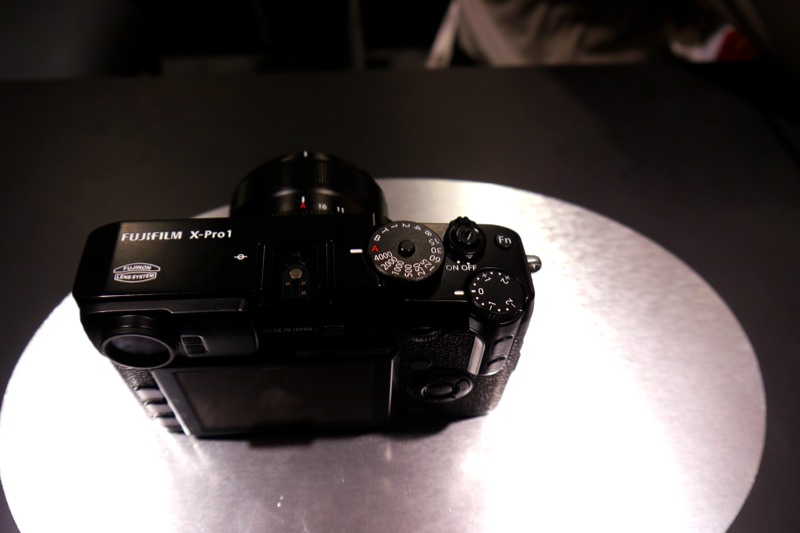
-
Samsung has introduced a new f/1.4 lens for their mirrorless NX200 camera. The lens makes the camera rather front heavy, but the lens shoots some beautiful photos. We need to see more fast lenses (my bias) like this for many of the mirrorless cameras. I found the NX200 to have a very clean user interface. Pretty much all controls are on the menus, but they are easy to navigate - the instruction manual for this camera is probably the best camera manual ever written (Nikon manuals come in closely behind this - they too are excellent).
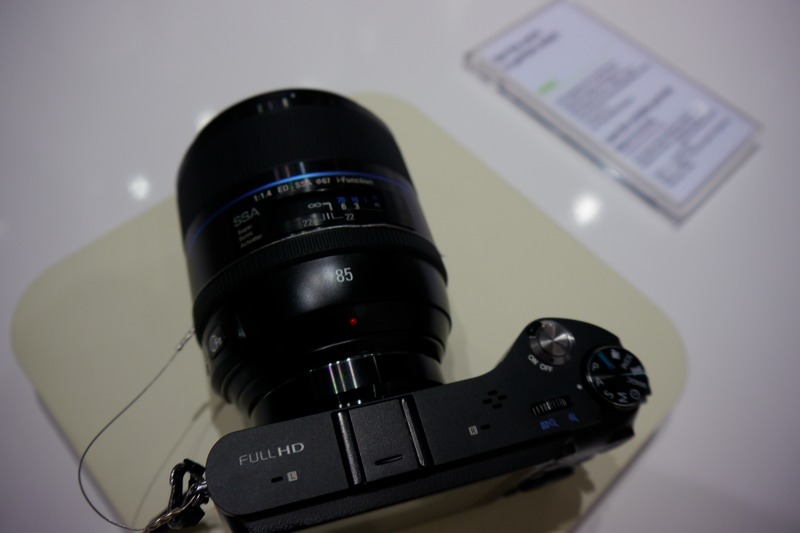
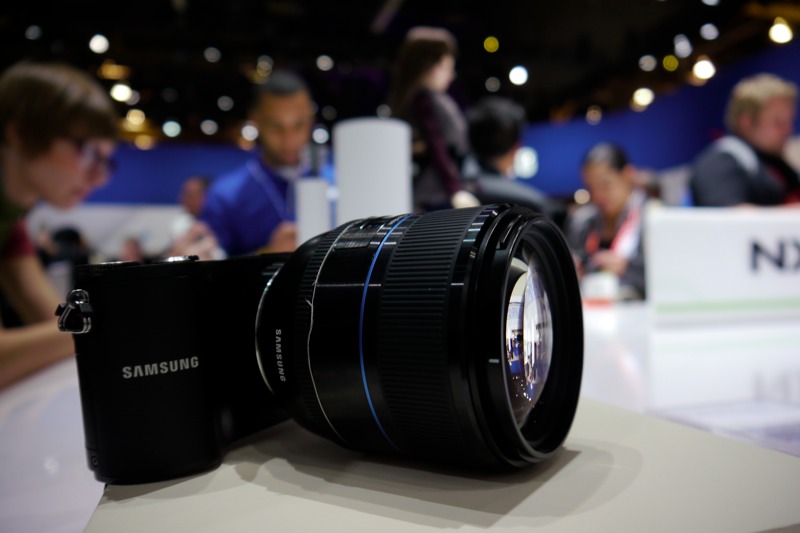

 P1030695.jpg800 x 533 - 52K
P1030695.jpg800 x 533 - 52K
 P1030697.jpg800 x 533 - 68K
P1030697.jpg800 x 533 - 68K -
Finally, the Fujifilm X Pro 1. A really interesting concept - it greatly resembles an SLR (not a DSLR). The control knob on top has shutter speeds - just like my old SLR. Very traditional styling, but impressive, modern features.
The X Pro 1 features both an optical viewfinder (rangefinder type), an electronic viewfinder, and an LCD panel.
They've got an APS-C sized sensor, but not just any APS-C sensor - this one is a new design that features very low noise levels and eliminates the moire pattern problem. I've heard that, at least some pretty impressive ISO levels, it has less noise than the Canon 5D.
The rep I spoke with did say that at 1080p, it is limited to 24fps.
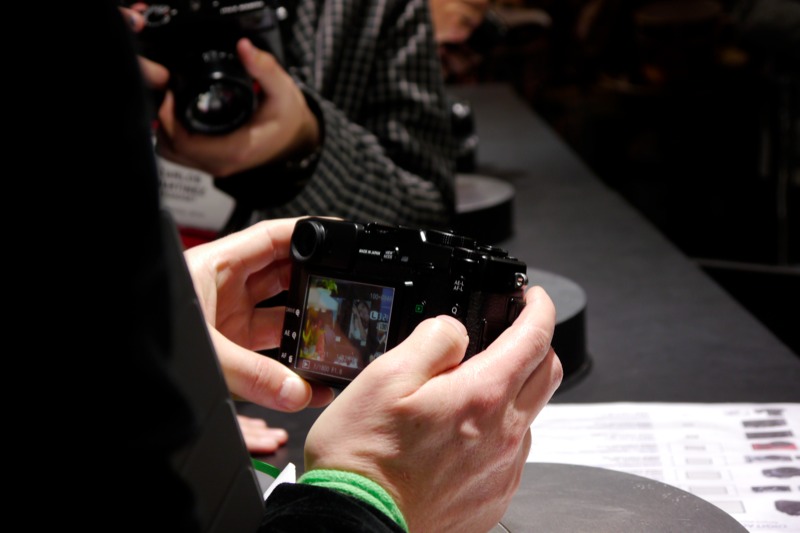
This 2nd photo shows the controls a bit better. At top left is an exposure compensation knob. The large knob to the right sets shutter speed, and other modes. I believe I heard the rep say that the camera will even accept a traditional shutter release cable.
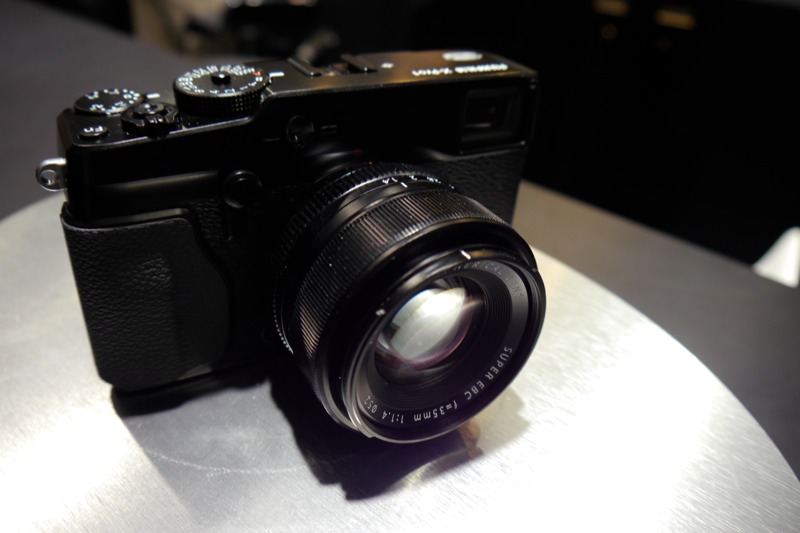
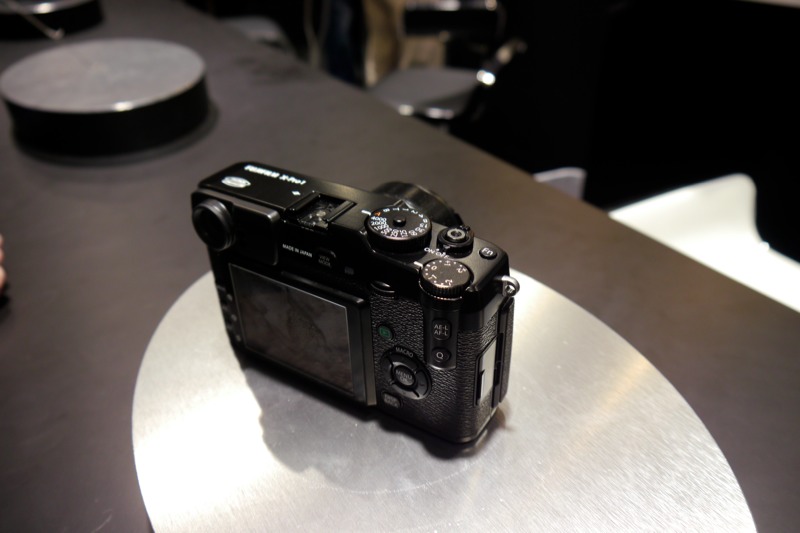
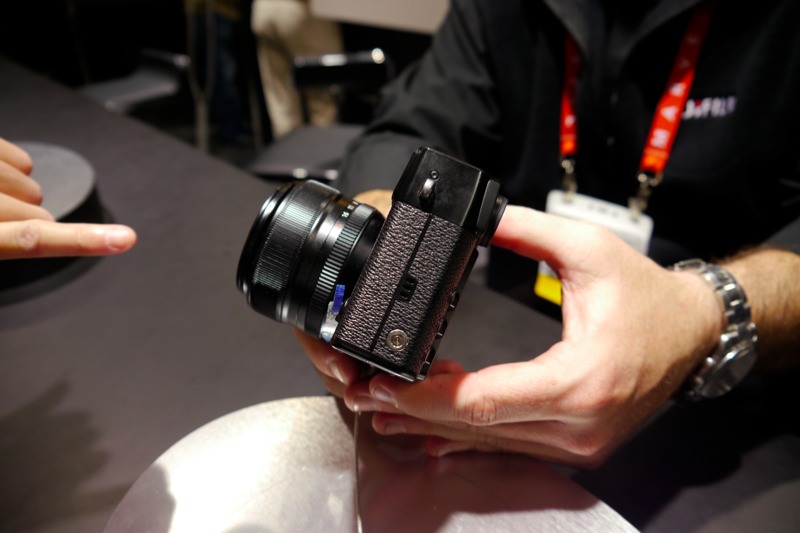
-
This post was an accidental duplicate - I deleted the text.

 P1030712.jpg800 x 533 - 66K
P1030712.jpg800 x 533 - 66K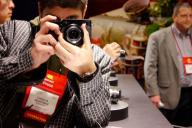
 P1030713.jpg800 x 533 - 113K
P1030713.jpg800 x 533 - 113K
 P1030717.jpg800 x 533 - 70K
P1030717.jpg800 x 533 - 70K
 P1030720.jpg800 x 533 - 68K
P1030720.jpg800 x 533 - 68K
 P1030721.jpg800 x 533 - 75K
P1030721.jpg800 x 533 - 75K -
Guys, remember to support Edward. Just donate and add "CES" as comment. He'll get all donations.
-
The Canon G1X. This new camera is a bit like their Powershots, but not really. First, it has an optical viewfinder, not electronic. Second, it has a large format sensor, almost as big as an APS-C sensor. This is the first compact-type, all-in-one, to feature a large sensor.
Unfortunately, the countertop folks did not explain the features and benefits of the G1X very well; may be they were tired. CES is pretty exhausting. But the G1X brings DSLR like capabilities to a high end, all-in-one, kind of like a point n' shoot camera. This also seems intended to compete with the large number of mirrorless cameras (the Samsung NX 200 has an APS-C sized sensor, for example).
The zoom and auto-focus both work while shooting video.
Overall, the G1X has similarities to the all-in-one Powershot, but with performance more like that of a DSLR. This might be purchased by someone that wants high performance, high image quality shooting - without having to carry a larger DSLR around. It might also be carried by a serious DSLR shooter who - at times - would rather just carry an all-in-one for convenience, yet get the quality shots typical of a DSLR.
I've also added a photo of the Canon ELPH 520 HS. These tiny cameras are amazing. Due to their compact size, a little camera like this would very useful for shooting 3D as a pair. With this small a camera, the two camera lens would be space fairly close as compared to trying to shoot 3D through dual DSLRs. (I shoot 3D using two GH-2s).
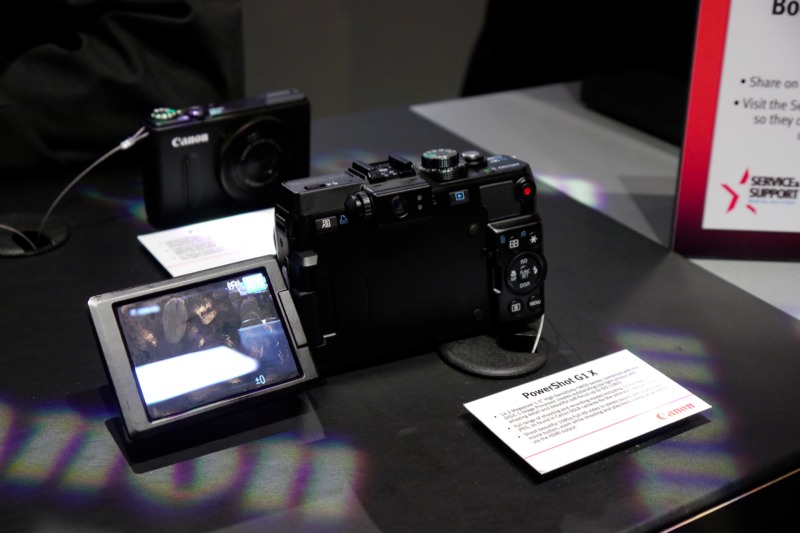
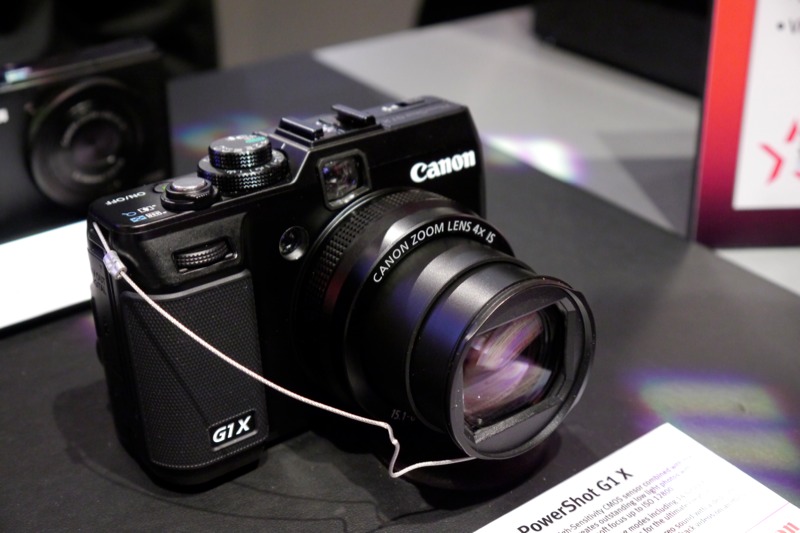
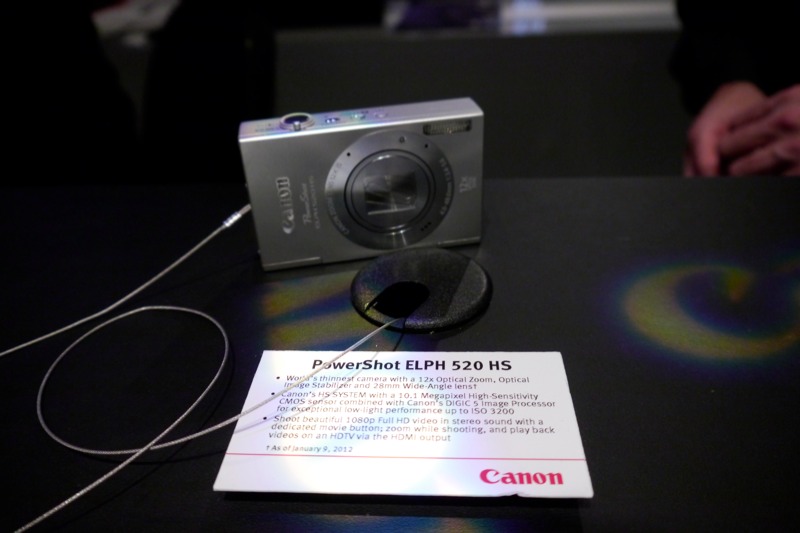

 P1030731.jpg800 x 533 - 80K
P1030731.jpg800 x 533 - 80K
 P1030738.jpg800 x 533 - 88K
P1030738.jpg800 x 533 - 88K
 P1030740.jpg800 x 533 - 70K
P1030740.jpg800 x 533 - 70K -
This is raw footage of Panasonic's 3D video cameras. Note the monitor atop the camera and how it oscillates back and forth between the left and right images, providing a simple glasses free 3D perspective for the camera operator. You should be able to see the 3D effect in this 2D video.
(At the time I posted this, the video clip was still being processed by Youtube)
-
Where's Olympus? Olympus does not have a public booth at CES this year. Instead, they are in private meeting rooms in the Convention Center only. No public display.
Pentax, acquired by Ricoh Imaging, is located in a separate convention center that I hope to visit on Thursday afternoon.
-
I had good conversations with some Panasonic people - suggested they need to get some faster lenses out, and had a conversation with some there on the need for some camera vendor - like say Panasonic - to release a software development kit for at least one of their cameras. I gave them the whole story on how this can create a network effect ecosystem that increases their market share and differentiates their products in the market. That means that 3rd parties add value (think of how 3rd part software makes Windows, Mac OS X, the iPhone more valuable to you as a consumer). As 3rd parties add value, the camera's "ecosystem" grows and everyone wins - more great ideas get implemented, more cameras get sold, 3rd party developers make money, and the consumer gets some great new capabilities.
I suggested they start with one camera, such as the GH-2 :) The guy I spoke with "got it" and said he will follow up with others at Panasonic. I intend to discuss this with more people - but I emphasized that the work done by the hacking community on the Lumix and the Canon cameras has created an enthusiastic group of followers and influences buying decisions. I bought a Canon Powershot a while back just so I could use CHDK and some scripts for some capabilities I wanted. When explained to them in terms of selling more cameras, they became very interested. This effort will take more than just this one conversation though.
A friend suggested camera companies may be afraid to allow this sort of "expansion accessory" and possible risks and loss of control. But as I pointed out, Apple lets 3rd parties write software for their iPhone and Microsoft/Nokia let 3rd parties write software for the Windows Phone. It can be dealt with.
I think they need to start with a single camera - preferably higher end - to understand the opportunity and the risks. And because the higher end enthusiasts are more likely to embrace this capability, initially. Can't wait to see that software development kit for the first software expandable camera!
-
@edwardm Can you ask Fuji about the bitrate of the X1-Pro? And about the shutter speeds for PAL area's? 24fps with PAL 50hz and NTSC shutter speeds 30,60,125 etc. don't go very well together. What about available controls during filming? What is the ASA rating for low-light? Does Fuji aim at the videographer/filmmaker?
-
If I get back to Fuji, I will ask about the bit rate on the X Pro 1 and PAL support. I should be able to check on the shutter speeds pretty easily - they are all listed right on the control wheel on top of the camera!
I can say that I do not think they are aiming at the videographer. The rep said, and re-confirmed when I asked, that they only shoot 1080/24p. I asked about 720p and he said he wasn't sure on that. My sense: he knew the camera inside and out on still photography but I do not think he had given much attention to video. That's why I do not think they are aiming this at videographers, even though it does shoot video.
-
@edwardm - if possible ask how video is achieved - how the camera downscales it's image for video.. Though quite possibly they have no idea about that. It would also be good to know if they have incremental stops of shutter speeds aswell (adjustable from menu or something like that?).
-
@Edwardm Could you add some information about JVC 4K camcorder with intercheangable lens? Price, settings, etc.. Thank you
-
The JVC 4k is a "reference exhibit" which means no price info. What they did say is that it has a 1.25" (about 32mm) 8.9 megapixel sensor. I assume they mean 1/1.25 sq in but that is not what the display said.
-
Thank you edwardm
-
Some answers to earlier questions
-
the JVC 4k camera "reference model" works with Nikon F-series lenses
- the Fujifilm rep said, in response to PAL and 25p support question, that Fujifilm is an international company and recognizes the importance of 25p support. He did not answer the question, but I do not think he knew the official answer. But that is a sensible answer.
- As to the data rate for video encoding on the X Pro 1, that information was not available. He did tell me that they view the X Pro 1's main focus as still photography, with some video capabilities, and that video is not the main focus of the camera. Every time I visited Fujifilm - about 4x - they were lots of people looking at the X Pro 1. It is a very unique camera with a lot of interest from camera enthusiasts.
- I asked another big photo company about their ever opening up a software development kit for even one camera. The guy I talked to was very technically knowledgeable but said that they have decided their policy is not to open up the cameras over concerns about 3rd parties creating solutions that would cause risks to their reputation, and gave some examples. He understands the desire and mentioned that, for example, they have had requests to put a bar code reader in their cameras, and this is the sort of creative feature that could be added by a 3rd party software developer.
- My wife (who is not a photographer!) suggests that a camera company might, perhaps, OEM a camera model to a partner, who sold the camera under a different brand name and with product differentiation, so as not to risk the well known brand. That is an interesting idea.
- The other possibility would be for a bunch of us to get together and define our own open camera platform.
I will probably post more photos later. Time for a late dinner now!
-
There was one more question about the ASA/ISO rating for low light on the X Pro 1. I did not get specifics but I heard from someone who said that the X Pro 1 has lower noise than the 5D at some of the very high ISO settings (don't know which settings though). Anyway, that would be an impressive achievement in a much smaller camera than the 5D!
Personally, I like small cameras. I completely understand why people like their 5Ds and soon, their Nikon D4s, but I now have a bias towards small, having carried my Canon XH A1, with two shot gun mics, on many a trip! -
Photo of sample lens next to JVC 4K camcorder, plus the electronic sign on the wall.
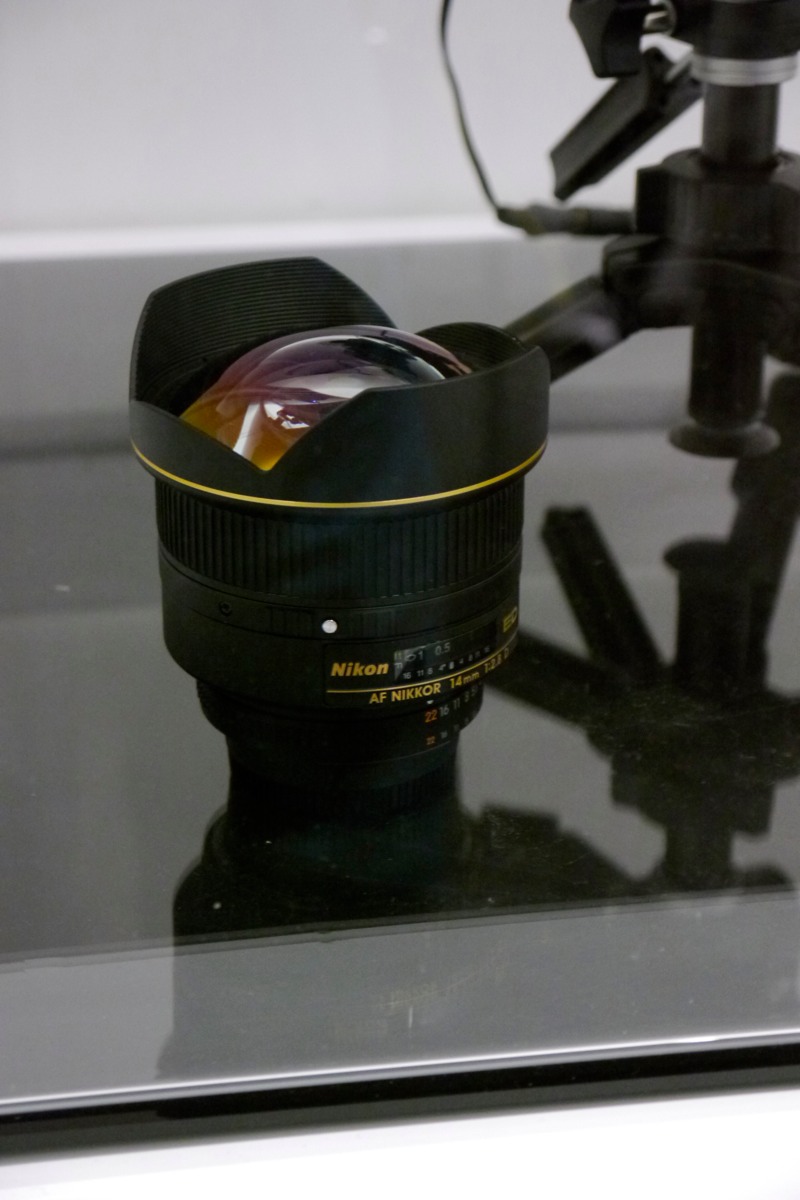
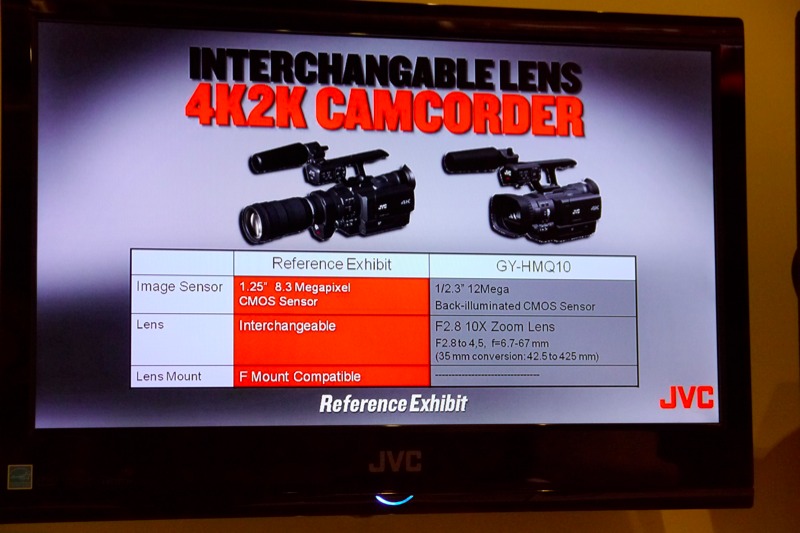

 P1030822.jpg800 x 1200 - 138K
P1030822.jpg800 x 1200 - 138K
 P1030825.jpg800 x 533 - 100K
P1030825.jpg800 x 533 - 100K -
Nikon D4 skeleton.
Nikon D4 sensor.
Nikon D4 ASIC.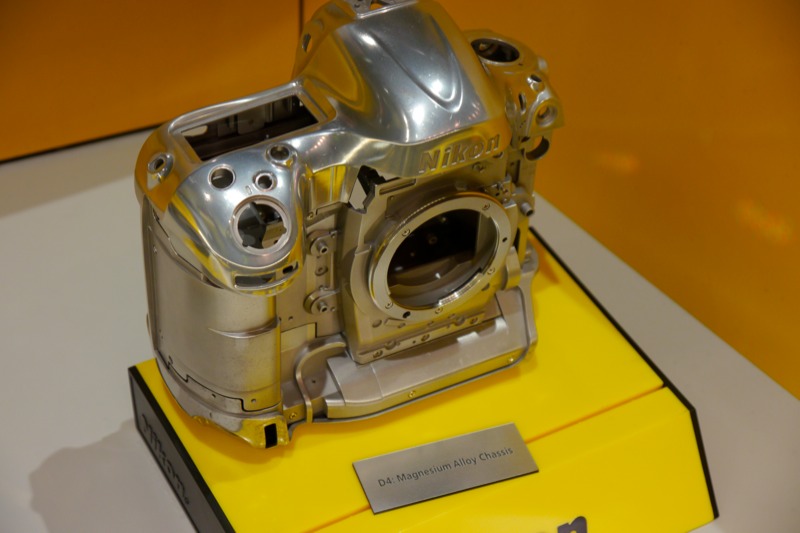
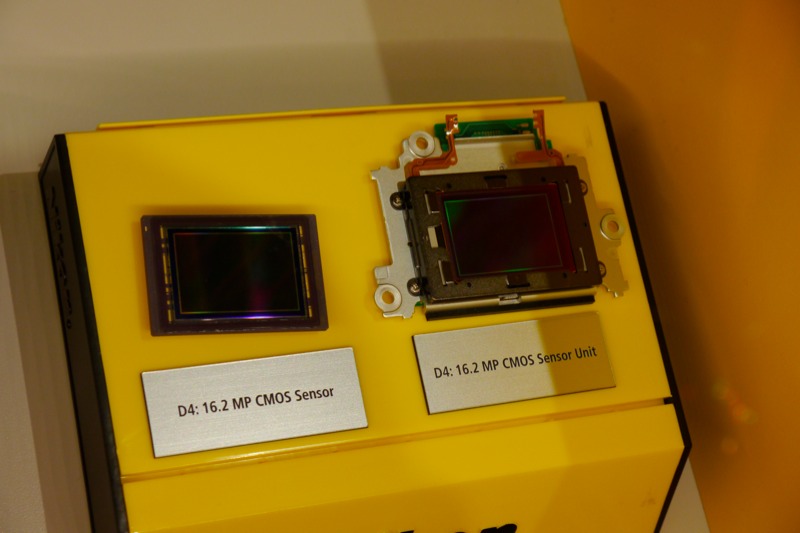
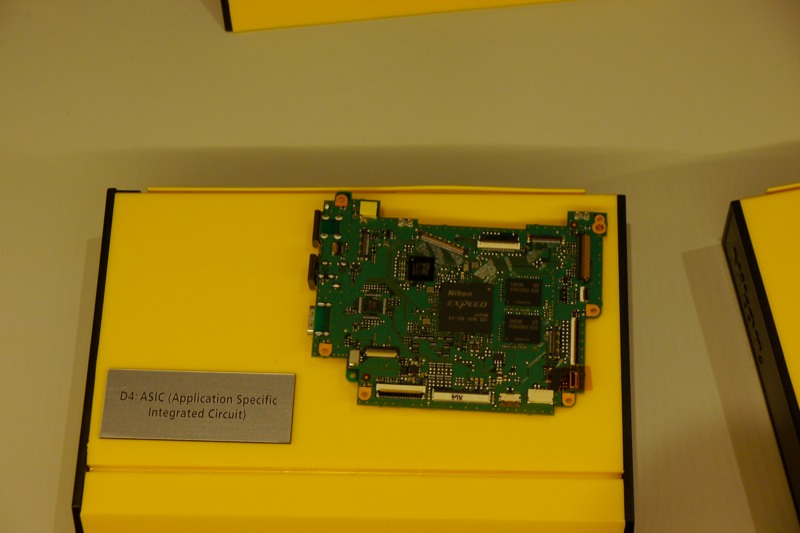

 P1030830.jpg800 x 533 - 78K
P1030830.jpg800 x 533 - 78K
 P1030832.jpg800 x 533 - 70K
P1030832.jpg800 x 533 - 70K
 P1030835.jpg800 x 533 - 69K
P1030835.jpg800 x 533 - 69K -
This is a slick camera rig out of startup business, being shown in the Eureka Tech Hall at CES/Venetian. The product is a machined light weight bar, with handles, that is holding the two cameras and accessories. Comes in different sizes.
Several cameras can be mounted at any position along the bar. As a new 3D enthusiast, this set up caught my eye since it makes for simple adjustment of the interaxial distance (in English, the horizontal distance between the dual camera lenses for stereoscopic 3D).
The mount is also used to hold say, a still camera and a real video camera, for event photographers who need to shoot both; or, can be used for multi-camera panorama shots and perhaps even a 360 degree set up. More info at www.parazzio.com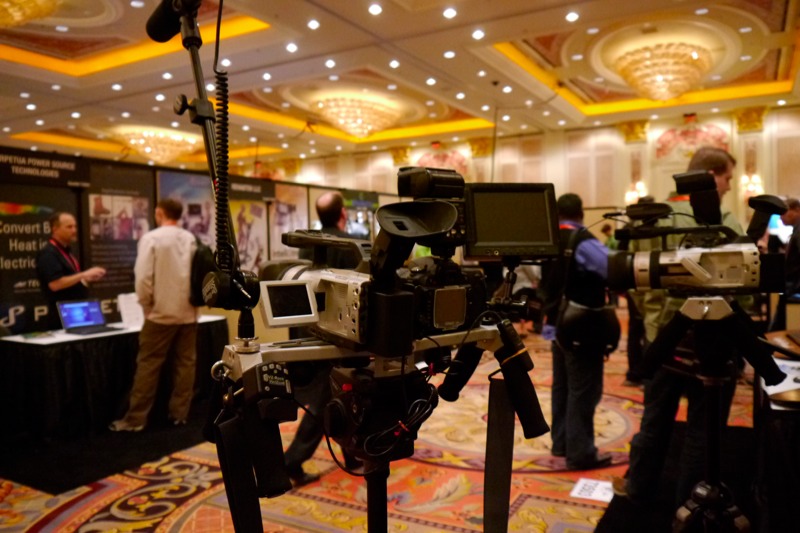
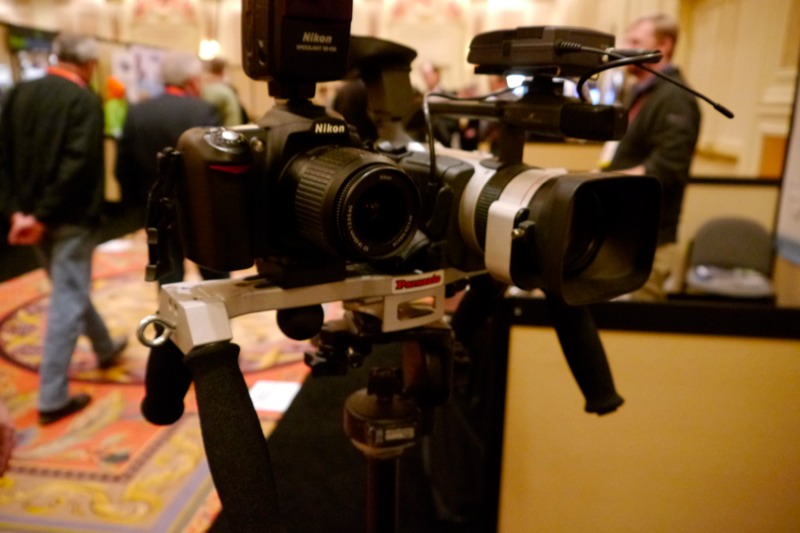

 P1030846.jpg800 x 533 - 120K
P1030846.jpg800 x 533 - 120K
 P1030847.jpg800 x 533 - 88K
P1030847.jpg800 x 533 - 88K -
SnapitHD has this interesting fish eye lens, all weather camera, with a huge field of view. They've got software that processes the images so you don't see the gigantic fish eye view but only a perspective corrected section. You can then scroll around the view - without having to move the camera. Since this camera sees everything, I ended up in a self portrait all bent out of shape.
The image can be sent via WiFi or wired networks or even cellular.
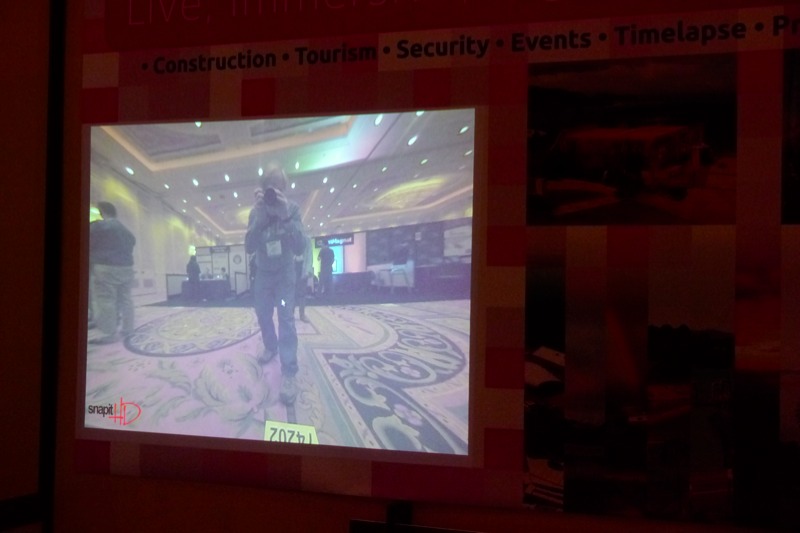

 P1030853.jpg800 x 533 - 70K
P1030853.jpg800 x 533 - 70K -
Nikon = Cylon
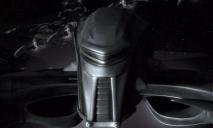
 cylonraider.jpg640 x 384 - 60K
cylonraider.jpg640 x 384 - 60K
 NikonD4chrome.jpg800 x 533 - 78K
NikonD4chrome.jpg800 x 533 - 78K -
Thanks for the write up on the SnapitHD Cam. It was good to meet you! See: www.snapithd.com for more information which is coming on the 360 Cam ;)
-
Fuji X Pro 1 manual available http://www.fujifilm.com/support/digital_cameras/manuals/pdf/index/x/lens_fx18_fx35_fx60_manual_01.pdf
To add to point about 1080/24p above. There is sadly no manual control in video mode.
-
I have more things to post but I got really sick last week and am still just getting over this - plus I am now behind in everything. Oh well.
This is the back of the Canon "booth" at the 2012 CES where you can check out Canon's telephoto and zoom lenses on actual cameras. Directly behind me is the Sony "booth" (I put that in quotes because these are enormous "booths") and when I took this photo, Sony had the music group "Earth, Wind & Fire" performing on the Sony stage. Guess where everyone had those Canon lenses pointed?
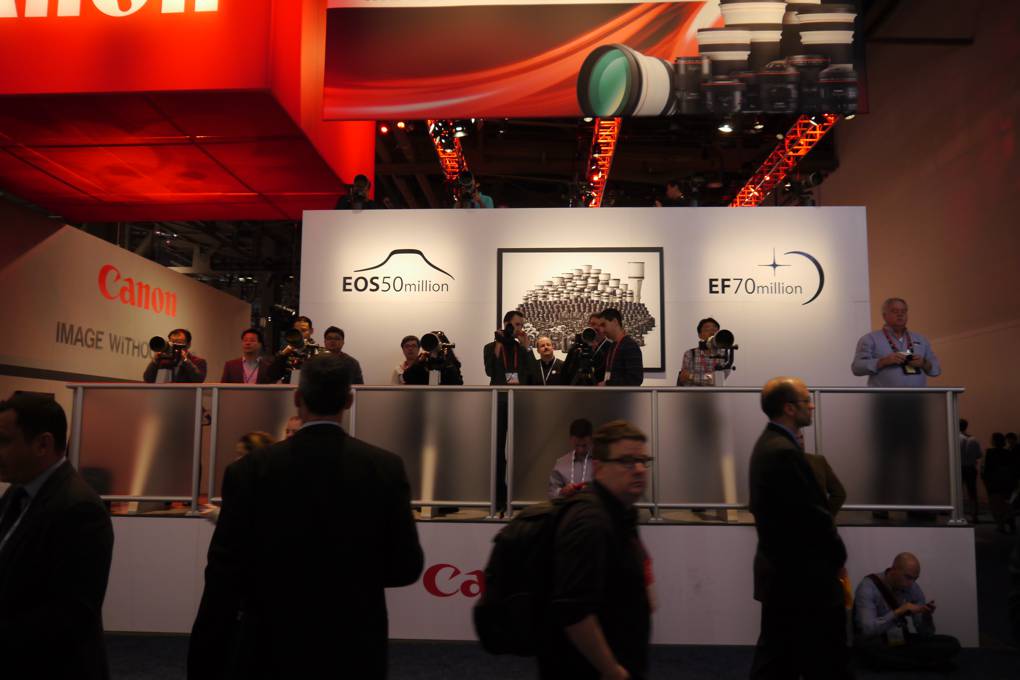
This next item is a very cool mount from Manfrotto. As we all want to mount extra stuff on our tripods (lights, mics, 2nd camera), lots of vendors have come up with various mounting brackets. This little ball mount has holes all over it, in to which you can insert extender tubes. Using this, you can mount just about anything, anyway you want.
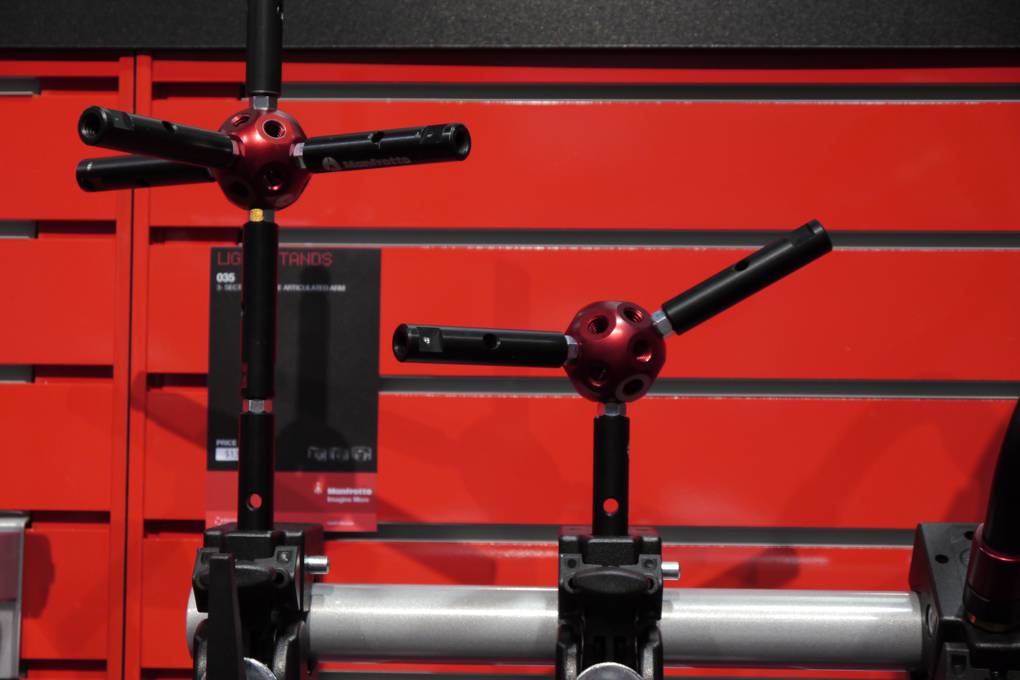

 P1030653.jpg1020 x 680 - 60K
P1030653.jpg1020 x 680 - 60K
 P1030662.jpg1020 x 680 - 55K
P1030662.jpg1020 x 680 - 55K
Howdy, Stranger!
It looks like you're new here. If you want to get involved, click one of these buttons!
Categories
- Topics List23,964
- Blog5,723
- General and News1,342
- Hacks and Patches1,151
- ↳ Top Settings33
- ↳ Beginners254
- ↳ Archives402
- ↳ Hacks News and Development56
- Cameras2,361
- ↳ Panasonic990
- ↳ Canon118
- ↳ Sony154
- ↳ Nikon96
- ↳ Pentax and Samsung70
- ↳ Olympus and Fujifilm99
- ↳ Compacts and Camcorders299
- ↳ Smartphones for video97
- ↳ Pro Video Cameras191
- ↳ BlackMagic and other raw cameras121
- Skill1,961
- ↳ Business and distribution66
- ↳ Preparation, scripts and legal38
- ↳ Art149
- ↳ Import, Convert, Exporting291
- ↳ Editors191
- ↳ Effects and stunts115
- ↳ Color grading197
- ↳ Sound and Music280
- ↳ Lighting96
- ↳ Software and storage tips267
- Gear5,414
- ↳ Filters, Adapters, Matte boxes344
- ↳ Lenses1,579
- ↳ Follow focus and gears93
- ↳ Sound498
- ↳ Lighting gear314
- ↳ Camera movement230
- ↳ Gimbals and copters302
- ↳ Rigs and related stuff272
- ↳ Power solutions83
- ↳ Monitors and viewfinders339
- ↳ Tripods and fluid heads139
- ↳ Storage286
- ↳ Computers and studio gear560
- ↳ VR and 3D248
- Showcase1,859
- Marketplace2,834
- Offtopic1,319




